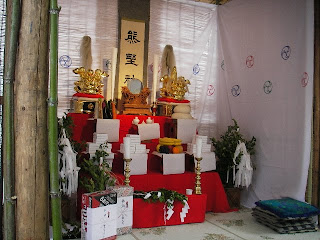Because deities are usually shut away deep inside shrines,annual MIKOSI parades are a rare chance for the local people to get close to them. In ancient times, the emperors and aristocrats in KYOTO would ride in palanquins called KOSI. For the palanquins used to carry the deities, MI :the Japanese word for God, was added, making the word MIKOSI. Gradually, this practice of carrying the deities around local neighborhood spread throughout the country.
 A MIKOSI is composed of three main sections:
A MIKOSI is composed of three main sections:First, is the central chamber. This is where the deity resides during the festivals. So it is the most component of the MIKOSI. A small TORII shrine gate is usually placed next to the chamber. TORII are erected at the entrance to shrines to symbolize that the ground inside is sacred. The central chamber of the MIKOSI represents the shrine itself. A roof are decorated with a phoenix, which is believed to be highly auspicious. According to legend, the appearance of a phoenix heralds the birth of a great ruler.
The main structure and roof are supported on a base fitted with poles, so that the MIKOSI can be carried around. The bearers support the poles on their shoulders. In some festivals, they jog the MIKOSI up and down as they carry it. This movement if believed to stimulate the deity inside, heightening its powers. Transferring the deities into MIKO and parading them around the streets... This is the way Japanese people deepen the connection with their local deities.
 There is some offering like foods and Japanese SAKE .
There is some offering like foods and Japanese SAKE .
No comments:
Post a Comment